

1787 Holzhey organ at the Abbey Church of Saint Peter and Saint Paul, Weissenau, Germany
2016-02-16 - Sample Set Spotlight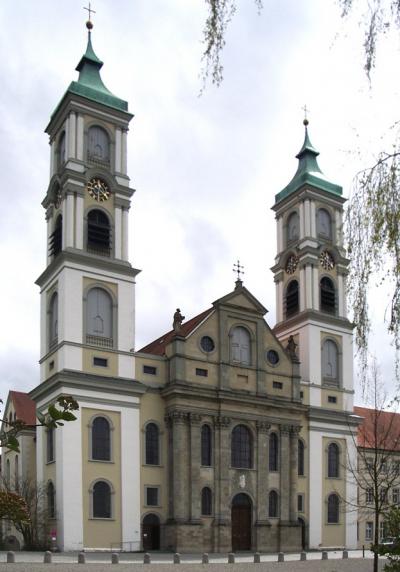
The great baroque Abbey Church of Saints Peter and Paul, Weissenau, Germany - West Front.
The abbey of St. Peter and Paul was founded in 1145 by Gerbizon Ravensburg ministerial Guelph. The congregation, formed canons of the abbey Rot-an-der-Rot, settled there under the protection of . Hermann I. The foundation stone of the college was laid in 1152 and the consecration of the building took place in 1163. This early Romanesque edifice was a basilica with three naves. With the rise in the Bailiwick abbey in 1257, Rudolf of Hapsburg in 1283 entrusted the priests with a relic of the Holy Blood. Thus the abbey became a popular shrine, mentioned elsewhere in the tale of Lohengrin. It remains today a traditional place of pilgrimage dedicated to Mary Magdalene.
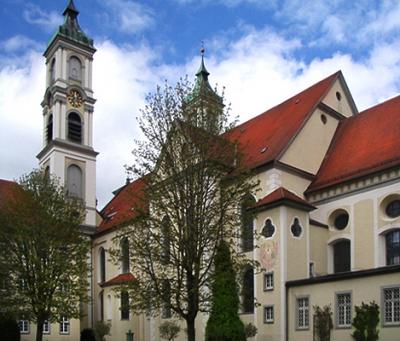
The Church from the North Side.
In the early 18th century, the canons decided to rebuild the abbey. Mauch, the imperial prelate entrusted the construction work to an architect Constance, Franz von Blaichten Beer, who completed work in the Baroque style in 1724.

The church from a distance, looking East.
Through a complex process of secularization, the great chapel of St. Peter and Paul was established as a parish church. The grounds and buildings remained intact, but were converted to a great variety of uses. The baroque church of Sts. Peter and Paul serves as parish church for the faithful of the Catholic faith. The large Baroque organ, the work of Johann Nepomuk Holzhey serves both for the liturgy for concerts. The convent buildings, meanwhile, were in 1892 converted to clinic. Then, under the Nazis, this public institution of Württemberg served as a rest house. But in 1940, the fate of the buildings became even more sinister, as the medical facilities became a notorious center for euthanasia.
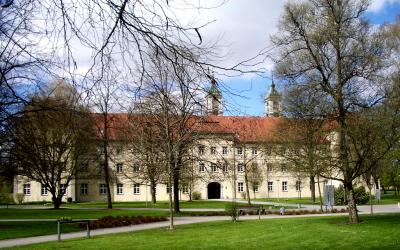
Some beautiful buildings have dark, shameful pasts.
Many of the old (and also some new) buildings are now designated as a Regional Psychiatric Centre. Nearby, Rahlenhof, the former summer residence of the abbots Weissenau, is now a clinic for the infirm. The ceremonial hall of the convent buildings, with the the stucco ceilings richly carved, is used as a 300-seat concert hall.
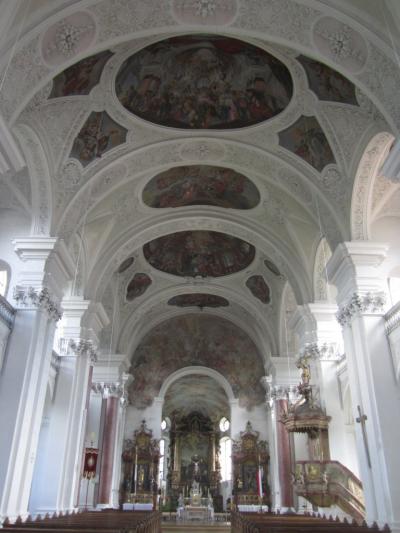
The great Baroque Nave looking East to the High Altar.
Central to the musical and cultural life of the church and community is the great organ built by Johann Nepomuk Holzhey in 1787. This instrument, which is "monument-protected" is famous throughout the world for the unique sound that it, and the other organs built by Holzhey share. It is a "blend" of national schools of organ sound, and looks forward in what was a very "modern" design.
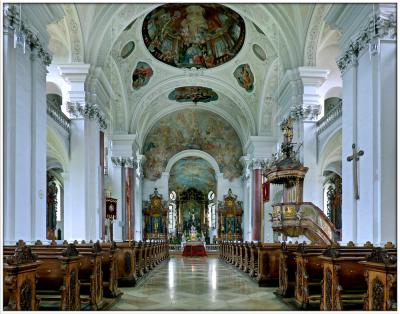
In the Nave, looking East.
Holzhey, who was born on February 26, 1741, had his workshop in Ottobeuren. It was here that his firm built over 40 organs, and earned him the title of the most "famous organ builder in Schwaben." He studied with and apprenticed under Karl Joseph Riepp, and in honor and recognition of his work, was inducted in the Ottobeurer Confraternity of the Rosary in 1768. He was one of the most sought after organ builders of his day, and was admired for the unique and "novel disposition" of his instruments. Johann Nepomuk Holzhey died on September 18, 1809 at the age of 68.
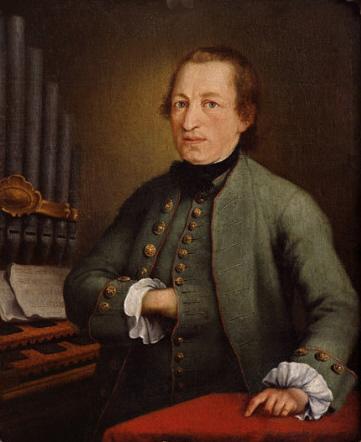
Johann Nepomuk Holzhey (1741-1809)
Today, Holzhey is recognized as one of the great South German master organ builders in the second half of the 18th century. He created a distinct approach to the organ, and his instruments rightly belong to the rococo and classical periods. However, in his later works the influence of romantic sound aesthetics becomes more and more perceptible. He was a contemporary of Haydn and Mozart. Holzhey's work represents the zenith of classicistic organ building in South Germany.
Holzhey was presumably educated by his uncle Alexander Holzhey. He received most significant ideas for his work from Karl Riepp. While his uncle built instruments in South German style, Riepp practiced French organ building. Those two styles could not be more different. Holzhey's masterstroke was to combine both styles and thus create tonally highly appealing instruments. His contemporaries frequently marvelled at how soft but also how powerful his organs sounded.
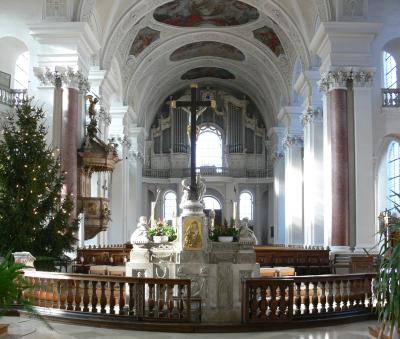
Behind the High Altar looking West.
The design of the great organ at Weissenau is a thoroughly classic one, but the tonal characteristics show the builder's unique and developing thoughts and ideas about organ tone. Spread over three manuals and pedal, the instrument provides a foundation for performance of music of varying nationalities and time periods, and always with integrity and beauty.
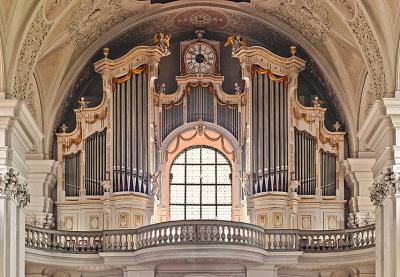
The Great Organ.
So, now that we've learned something about the history of the abbey, from monastic community to parish church, and gotten to know Herr Holzhey a bit, let's take a look at the organ, and see what gives it distinctive sound.
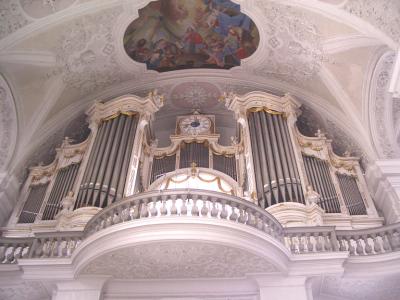
Looking up underneath the organ loft.
Let's start with the main foundation of any organ - the Great manual, or, speaking properly, the Hauptwerk. In this instrument, the Hauptwerk is the lowest manual, so, it's at the bottom of the physical arrangement of the keys. It is a very complete division, and represents itself with a complete chorus of principals, from 16' through 2', along with a variety of flutes and strings. The French influence makes it's presence known by the addition of bright reeds in the Trompet 8' and Claron 4', and these are tonally reinforced by a Cornet, which will help "hold the reed tone" in the upper registers. The piquant Quintadena 8' makes a surprisingly strong statement, and it alone can change the color of the ensemble! And the strings!!! How often do we find a real and genuine string celeste on a Great manual?!? And this is a real celeste to, not just a slightly out-of-tune stop that is hard to find a use for. Just for the record, the Gamba is the "main" string rank, and the Viola provides the celeste or schwebung. The 6-rank Mixture is not overly bright, and it does have a significant tierce in it. I know that this "type" of mixture annoys some organists in certain types of literature, but it works grandly here, and is part of the the characteristic sound of this organ.
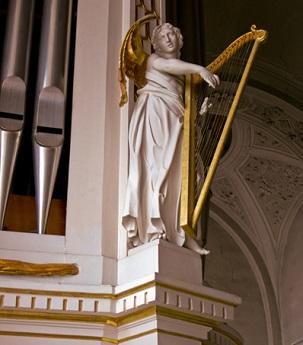
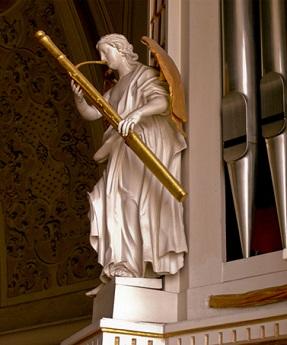
Angels - praising God with strings and pipe.
Moving up to the next manual, we come to the Positiv - the Choir manual. As typical with the South German tradition, the Positiv is really a "small Great", and is composed of a complete Principal Chorus, right through the "brightest" mixture on the entire organ. I'm not sure exactly what the composition of this mixture (Cimbal) is, but it sounded more "regular" to my ears, without any hint of a prominent tierce rank. The Flautravers is overblowing, so, it's really an harmonic flute, and once again we have "romantic" strings with the Salicional 8' being the main string, and the Unda Maris 8' being the schwebung. An interesting and useful feature is the "divided" reed stop, here, and also on the Echo division. By "divided" I mean that the one "rank" has two "stops" which "divide" at middle-C. On the Positiv the reed stop is a Fagott 8' in the bass, and an Hautbois 8' in the treble, or "diskant." So, you could draw say the Hautois and the Rohrflöten 8', and "accompany" the reed solo with the flute - provided that your "melody" doesn't go below middle-C! Whether divided or not, I felt that the Fagott/Hautbois was very "trumpet-like," and quite a bit "bigger" that I was anticipating.
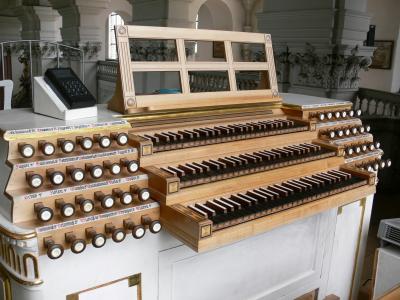
The console. Legend says that Mozart used this phone...
Going up to the top manual is the Echo division. As Dr. Ulrich Höflacher writes: The pipes of the third manual (Echo) reside behind closed doors in the foundation of the organ. This division consists of flutes, a string, two solo reeds (both the Vox Humana 8' & the Cromorne bass/Schalmei diskant are divided) and a Cornet for solistic playing. French traditions are unmistakeable although Holzhey redesigns the Cornet division. By means of dividing the reeds it becomes possible use them as solo stops and simultaneously accompany them on the same manual. Thereby the Récit division of the French organ (which Riepp used to build) becomes unnecessary. In addition, the Echo Cornet is tonally tamed and is no longer the radiant solo stop. So, in essence, Holzhey has made "4 manuals out of 3" by the divided solo stops. There is also a Tremulant on the Echo. It is the only Tremulant on the entire organ, and is very mild.
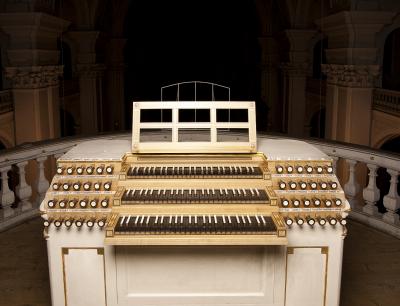
The console at night.
The Pedal Organ appears to be small, but the voicing and scaling is very generous. There is only one 16' foundation stop, the Subbass, but is big enough to support the full organ, and "soft" enough to be used in quiet pieces. There are two 8's stops, and the 4' Cornetbass, is really a "mixture" stop. I expected to find this problematic, but in reality, it is very useful and successful. The three reeds, Bombard 16', Trompet 8', and Clarion 4' are all quite big and on the fiery side.
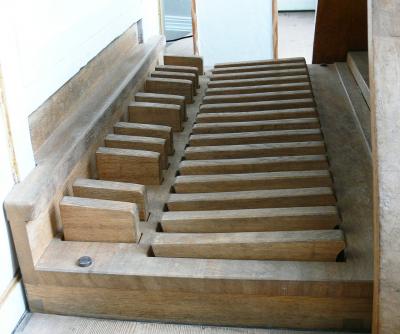
The pedalboard - I don't think that the heel and toe system would work too well here...
So, before we get down to a few "demonstration pieces," let's take a look at the complete specification, and then I have a few thoughts about the sample set itself.
Hauptwerk
Prestant 16’
Principael 8’
Copel 8’
Quintadena 8’
Gamba 8’
Viola (Schwebung) 8’
Octav 4’
Flöten 4’
Nasard 2f. ’
Superoctav 2’
Sexqualter 3-4f. 3’
Mixtur 6f. 2’
Cornet 3f. 3’
Trompet 8’
Clairon 4'
Positiv
Principal 8’
Rohrflöten 8’
Salicional 8’
Unda Maris (Schwebung) 8’
Flautravers 8’
Octav 4’
Holflöten 4’
Fugari 4’
Quint 3'
Syflöt 2’
Hörnle 2’
Cimbal 5f. 2’
Fagott bas 8’
Hautbois discant 8’
Echo
Nachthorn 8’
Dulciana 8’
Spitzflöten 4’
Flageolet 2’
Cornet Resit 4f. 4’
Vox Humana bass 8’
Vox Humana diskant 8’
Cromorne bass 8’
Schalmei diskant 8’
Tremulant diskant
Pedal
Subbass 16’
Octavbass 8’
Violonbass 8’
Cornetbass 4’
Bompard 16’
Trompet 8’
Clairon 4’
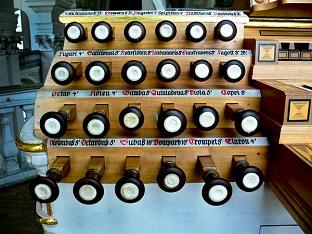
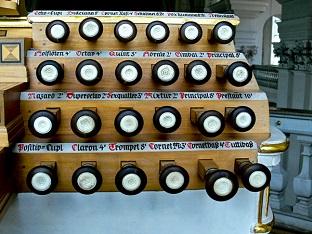
The stop jambs on the actual console.
Of course by now, you know that the 1787 Holzhey organ at the Abbey Church of Saint Peter and Saint Paul, Weissenau, Germany is produced by Prospectum. and you can learn full details of the product by looking the organ database with links to their webpage.
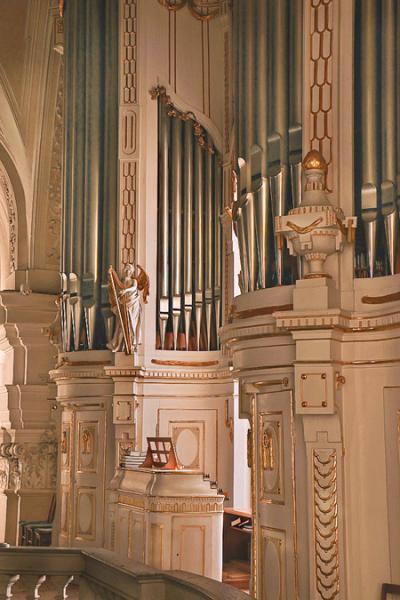
The organist's office.
The very first things that you notice about this sample set is the immaculate production, the attention to detail, and the very high level of quality. From the "variable listening location control" to the multiple releases, to the stop action and room noises, to the spectacular sound of the virtual instrument, everything is glorious. The control screens are easy to use, and the animated virtual console is itself a thing of beauty. The temperament is the "correct and original" one, and although it is similar to similar to the Werckmeister of 1691. there are subtle differences.
I particularly appreciate the "fully functional" virtual console. Everything works on it, and it's great to have it as your main screen when playing. Each stop is loving captured, and you really could want nothing more from a sample set than you will find here.
So, let's get on with the music!!!
Before I say a few things about each of my "demo recordings," I would call to your attention a large number of performances already uploaded on the Concert Hall. If you want to hear the "classical" aspects of this organ, than check out the uploads by Bartfloete. If you think an "old" organ like this can't handle contemporary music, than listen to ground-breaking uploads of CarsonCooman. If you want to hear the great Prelude and Fugue in E Minor, BWV 548, than you must certainly check out the version by Aarnoud here: https://www.contrebombarde.com/concerthall/music/19575, and you'll understand why Ewald Kooiman chose this organ to record his "9 Great Preludes and Fugues" (Bach).
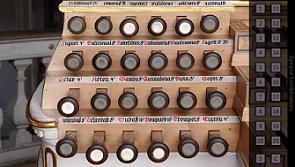
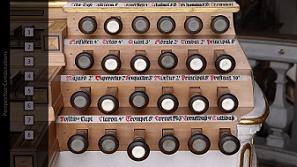
The very realistic virtual console stop jambs with lighted stops.
For my "demos", I tried to pick pieces that would showcase various, and hopefully distinctive sounds of this wonderful instrument.
For my first piece, I did an Italian Baroque Toccata by Bernardo Storace. It demonstrates the "silvery" sound that can be achieved with this plenum. The Cimbal of the Positiv is the "crown on the sound" in this ensemble. You can find this piece here: https://www.contrebombarde.com/concerthall/music/19652
Next I chose Flutes by Jean-Henri D'Anglebert to show, as you might guess, the flutes! These are all the 8' flutes (without the Quintadena) coupled together. While I did miss the tremulant somewhat (only the Echo has a tremulant), the sound and texture is exquisite. You can hear this piece here: https://www.contrebombarde.com/concerthall/music/19653
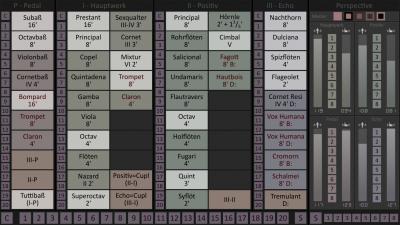
The cockpit shop with a very well-designed control panel.
For the next 2 works, I chose two chorale preludes by the great Johann Pachelbel. I felt it was absolutely necessary to represent him on this southern German organ. The first, Erbarm dich mein, O Herre Gott, uses the "darker" plenum of the uncoupled Hauptwerk, with the tune appearing in the pedal, which uses the prominent Bombard 16'. You can hear this piece here: https://www.contrebombarde.com/concerthall/music/19654 The second Pachelbel chorale, O Mensch bewein dein sunde gross is a lighter in texture, and features the Flutes 8' & 2' of the Echo, with the very orchestral sounding Violonbaß 8' for the melody in the Pedal. You can find this work here: https://www.contrebombarde.com/concerthall/music/19655
My next piece is Basse de Cromhorne by the famous Louis Marchand. While you can here that the Cromorne/Schalmei of the Echo is not a real French Cromorne, it is a very lovely stop. More gentle than the French example, you will need to draw both the Bass & Diskant, as the range is a big one. You can hear this piece here: https://www.contrebombarde.com/concerthall/music/19656
The next piece is the sort of piece that you'd never play on a Baroque organ - but THIS Baroque organ is different and it WORKS! It's one of the little pieces from Cesar' Franck's L'organiste, and it features the contrasts between the strings of the Hauptwerk and the Positiv. You're hearing the strings (Gamba & Viola) of the Hauptwerk in contrast with those of the Positiv (Salicional & Unda maris). I've played each section twice, first on the Hauptwerk and then the Positiv. You can hear this piece here: https://www.contrebombarde.com/concerthall/music/19657
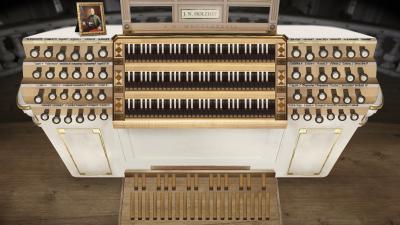
The beautiful and completely operational virtual console.
For my final demo, I've played the Prelude and Fugue in G Major, Op. 37, No. 2 by Felix Mendelssohn -Bartholdy. The Prelude uses the Flutes 8' & 4' of the Hauptwerk, and the Fugue starts on a fairly full plenum, and builds until the end, when an impressive climax is reached, and the ALMOST full organ is heard. You can find this piece here: https://www.contrebombarde.com/concerthall/music/19658
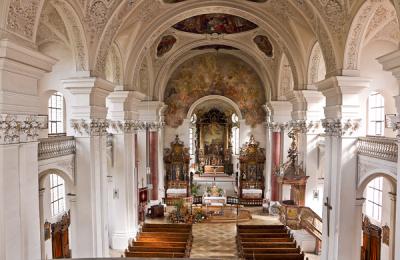
Looking down the nave towards the High Altar from the organ loft.
As with all of my Sample Set Spotlights, the thoughts expressed here are only opinions. In doing a review, I am always honest but positive. If I didn't like something, or think that something was good, I would say so. I express my sincere congratulations to Prospectum for achieving such a "high score" in producing this sample set. I also wish to thank them for making this set available to me - SINCERE THANKS, Gernot!
If you read the comments on the Concert Hall, those by the listeners and uploaders, the samplet set of the 1787 Holzhey organ at the Abbey Church of Saint Peter and Saint Paul, Weissenau, Germany is receiving rave "reviews" and virtually universal praise.
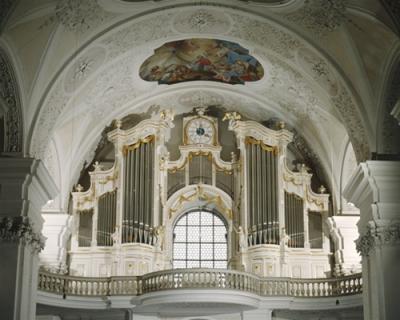
One last look at the glorious Holzhey organ.
If you are thinking of adding a new sample set to your collection, and are interested in impeccable quality, historical importance, and musical beauty, THIS sample set would an excellent choice!
Comments
Yes, I like the organ, and find that I do use it when I play "classical" literature.
Most of my music is "English cathedral-style," but I do like and admire this organ.
The very limited too loud/too soft pedal is the biggest limitation. There is really no way around this, so, you just have to use it and make the best of it.
It's an important instrument, to be sure!
Peace,
David